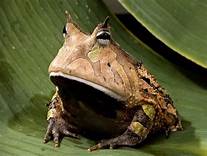The horned marsupial frog (Gastrotheca cornuta) is a nocturnal amphibian that lives high in the canopy of well-preserved tropical rainforests. Its persistence in western Ecuador is becoming more challenging due to habitat loss, mainly due to oil palm crops, timber, and mining.
 UNSEEN FOR MORE than a decade, the enigmatic and endangered horned marsupial frog has reappeared in an Ecuadorian forest, to biologists’ delight.
UNSEEN FOR MORE than a decade, the enigmatic and endangered horned marsupial frog has reappeared in an Ecuadorian forest, to biologists’ delight.
The frog’s looks are striking: It has horn-like skin flaps above its eyes and irises of gold. But this nocturnal tree-dweller is best known for its bizarre reproduction, which recalls a kangaroo’s. Eggs develop in a pouch on the mother’s back, and they hatch out as fully formed froglets rather than tadpoles. (See “5 Strange Ways Animal Mothers Carry Their Babies.”)
A team of biologists discovered the frog while exploring a remote part of the Chocó region in western Ecuador, just outside the Cotacachi-Cayapas Ecological Reserve. The biologists, from the conservation and ecotour group Tropical Herping, heard frog calls they didn’t recognize, and turned their flashlights on the palm leaves.
The horned marsupial frog had not been seen in Ecuador since 2005—until 2018. Its horn-shaped “eyebrows” and its capacity to carry its eggs in a pouch on its body, skipping the tadpole stage, make it highly unusual.
PHOTOGRAPH BY SEBASTIAN DI DOMENICO, TROPICAL HERPING
When they finally spied the noise-maker by its shining eyes and realized it was Gastrotheca cornuta, the horned marsupial frog, “we were so excited we started jumping up and down,” says team member Sebastian Di Domenico. They were able to collect four individuals, including a pregnant female, suggesting a stable population in a rare patch of healthy forest.
To Read the Entire Article Click Here: National Geographic

